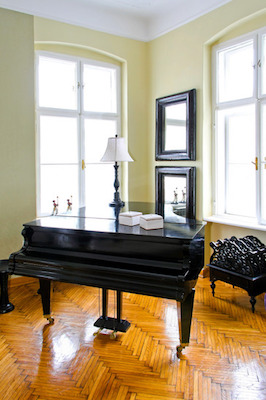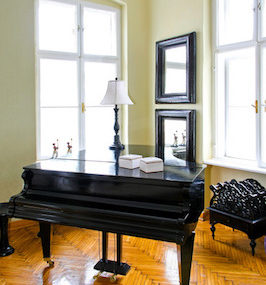When you set out to invest in the perfect piano for you, you probably consider things like type, style, manufacturer, even color. But have you stopped to consider the surrounding area?
Will your flooring choice be perfect for your piano investment?
Depending on where you’ve practiced and played, you’ve probably found the rooms to be decorated in many styles. You’ll find wood, laminate, even carpeting underneath. 
In general, wood flooring will increase volume, while carpeting will decrease volume. Thicker carpets will also further decrease the volume when compared to a thinner one.
Look to some of the greatest concert halls in the world, and you’ll find pianos live and on stage, surrounded by hard surfaces. Wood is often the flooring of choice, adding both elegance and ease to move a piano around.
And while that may provide you with direction for your own room, it isn’t the only factor that comes into play.
Grand pianos produce sound differently than verticals. What type of piano you own will impact the perfect flooring for your room.
But it does stretch beyond the flooring too. Projection is key – what sounds are produced when they collide with the surrounding area.
Loudness comes from voicing the piano and voicing the room.
Voicing the piano comes through the tuning process and ensuring the hammers create the right sounds for the music. Voicing the room comes from creating the best sound possible. That includes selecting the right flooring. And a lot more. Area rugs, wall hangings, cloth furniture, bookcases with books in them – all of it absorbs sound in different manners.
By adjusting one thing at a time, you’ll find your piano creates a different sound. Some will sound richer and fuller; some will begin to lose their spark.
If you’ve invested in a new piano and it simply doesn’t sound the way you’d desired, concentrate on your decor. Add and subtract things within your music room to give off a new wave of sound. You may be surprised at what combinations you can use to compliment the sound you desire.


